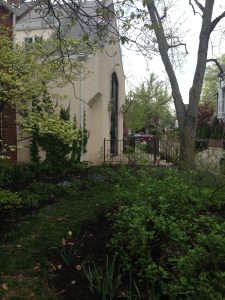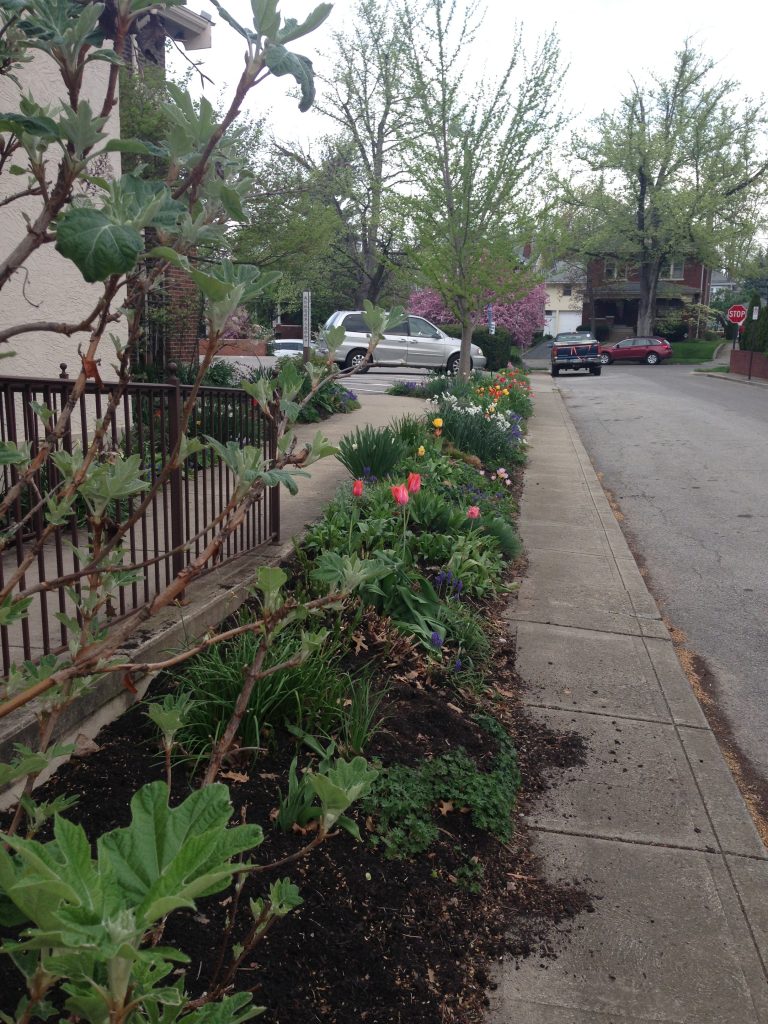“It is not hyperbole to talk about gardening as an act of making peace with the land, even on a small scale, as in a rain garden in the middle of a city. The world needs both the inaccessible wilderness of Eden and the urban garden refuge of Gethsemane.”
By Sarah Wengerd
Sarah presented this piece at the 2017 Rooted and Grounded Conference at Anabaptist Biblical Seminary, Elkhart, Ind.
The grounds of Columbus Mennonite Church face a quiet side street in a leafy neighborhood in the large city of Columbus, Ohio. One block from the bustling thoroughfare of High Street and nestled between the sanctuary and office wing of the church, a variety of small shrubs and flowers grow. A sign next to them indicates that this is a rain garden, no ordinary cluster of plants. At this moment in the heart of spring, there is riotous color everywhere. Tulips try to outdo daffodils poking out of the fresh mulch while the red leaves of the maple and the bright green of the tulip poplar create a thin canopy of color above. The three green leaves of Jack-in-the-Pulpit and trillium are growing beneath the low-arching branches of the flowering dogwood. Dandelions and tiny violets give the lawn a yellow and purple blanket, announcing that this is a pesticide-free space for flowers and grass alike. A bluebird perches precariously on the slender branch of a newly leafed-out bush while bees are hard at work above, flitting in and out of their hive high up in the maple tree.
 Rain gardens: A reminder of God’s presence
Rain gardens: A reminder of God’s presence
The rain garden at Columbus Mennonite Church reminds us of God’s presence in the created world and invites us to consider the landscapes that shape our lives as God’s people. In our modern and heavily populated world, gardens remain peaceful places of refuge in built landscapes, places to pray and be still and listen for the voice of God. When we build gardens we are attempting to recreate this place of primordial peace in our own small way and invite others to share in the bounty of creation.
Rain, in moderation, is a literal gift from heaven. The clouds gather, darkening the sky, and then open up, sending down cold rain in sheets to water the earth. It pounds on the roof and splatters mud on the flowers and drips down the leaves of trees, soaking into the ground to store for dry days ahead. But, this isn’t what happens in the middle of the city where there is more asphalt than earth. The rain runs hard and fast off of roofs and streets and parking lots, quickly making streams that push trash and motor oil and loose dirt into the storm drains and out to the river, causing it to swell like a high tide. Rain gardens, living roofs, and permeable concrete can all help to mitigate this flash flooding in urban areas. And unlike living roofs or permeable concrete, rain gardens require relatively little money and technology to implement.
Rain gardens such as the one at Columbus Mennonite have a practical function in addition to their aesthetic beauty, capturing the good gift of water to support life. Less than a mile to the west of the church, the Olentangy River flows south towards the city center, sometimes spilling its banks with muddy, oily runoff after heavy rainstorms. The 10 x 10 foot rain garden can absorb over 650 gallons of water at a time. Our rain garden was installed in the fall of 2010 by a local non-profit, Friends of the Lower Olentangy Watershed. It includes the rain garden, which captures water from a portion of the sanctuary roof; an eleven hundred gallon water reclamation tank that captures water from the remaining portion of the roof; and a retention trench that captures runoff from the parking lot. These elements together filter the water as it soaks into the ground and prevents flooding of the river downstream, diverting 100,000 gallons of water each year from the river and supporting the bountiful plant life on our small piece of land.
 Making a property welcoming
Making a property welcoming
The rain garden is only the latest project by Columbus Mennonite to make the church grounds more habitable to plant and animal life. When the congregation moved to the current building in 1998 there was almost no green space. The only landscaping was the small patch where the rain garden is now. The whole border around the parking lot and the sidewalk in front of the church and the peace garden was asphalt. The gardening group jack hammered it and built up the soil with compost and leaf mulch until it was enough to support life. One corner of the parking lot border is the memory garden where they have planted trees and shrubs in memory of some of the church members who have died. Now that the plants are established, they hardly ever need water unless there is an unusually long drought. As a result, the caretakers rarely use the rain barrel. Even those who might not be aware of the rain garden because it is tucked in a corner of the property notice the landscaping that frames the church. Flowers and shrubs surround both of the signs for the church, and several of the gardening group members I talked to mentioned that this is a witness to who we are as a congregation. It is more welcoming to visitors than asphalt.
The garden and native landscaping provide a green fringe of life around the church as a whole. They announce what we value as a congregation, and represent a vision of ecological restoration on a micro scale. The church has chosen to make the most of what little earth we do have. In the spring we are greeted by an ever-changing array of bright flowers; in mid-summer by the leafy canopy of trees; and in fall by the sunset colors of seeding bluestem grass and billowy yellow heads of goldenrod. In winter the ground is frozen and sometimes covered with snow, a blanket protecting bulbs and roots until the thaw and riotous color of a new beginning. The landscape also echoes the liturgical seasons of the church: the quiet darkness of mid-winter into which a child is born, the slow turn toward the light and manifestation of life renewed at Easter, then summer into fall when we celebrate the life and wisdom of God’s people. It is possible to simply pass all of this by of course, from car or city sidewalk into the building, but to do so is to miss out on a part of what it means to be a church for each other and our community.
We often think of peace as a manifestation of social justice; the fruit of justice and love is peace. But there are many more manifestations of peace beyond those involving human relationships: inner peace and peace with the land being two notable examples. It is not hyperbole to talk about gardening as an act of making peace with the land, even on a small scale, as a rain garden in the middle of a city. The world needs both the inaccessible wilderness of Eden and the urban garden refuge of Gethsemane. There has to be wild habitat for ecosystems to flourish, intact, as well as wild places in the city to connect us with green, growing things, and our evolutionary past in the soil. I’ll end with a quote from biologist E.O. Wilson: “mysterious and little known organisms live within walking distance of where you sit. Splendor awaits in minute proportions.” Biophilia 139
